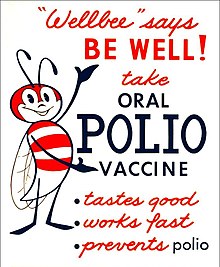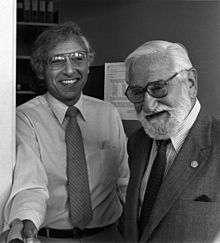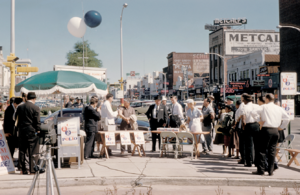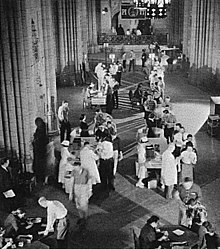
পোলিও টিকা
 একজন শিশুকে পোলিও টিকা খাওয়ানো হচ্ছে।
| |
| রোগশয্যাসম্বন্ধীয় তথ্য | |
|---|---|
|
এএইচএফএস/ ড্রাগস.কম |
মুলতুম ভোক্তার তথ্য |
| গর্ভধারণ বিষয়শ্রেণী |
|
| প্রয়োগের স্থান |
Parenteral (IPV), Oral drops (OPV) |
| এটিসি কোড | |
| আইনি অবস্থা | |
| আইনি অবস্থা |
|
| শনাক্তকারী | |
| কেমস্পাইডার |
|
পোলিও ভাইরাস থেকে বাঁচতে সারা বিশ্বে দুই প্রকার পোলিও টিকা ব্যবহার করা হয়, যেগুলো মুলতঃ poliomyelitis (পোলিও) নামক রোগের প্রতিষেধক হিসেবে কাজ করে। এই দুই প্রকার টিকার মধ্যে একটিতে অক্রিয় পোলিও ভাইরাস এবং অপরটিতে দুর্বলকৃত পোলিও ভাইরাস ব্যবহার করা হয়। এই দুই প্রকার টিকা যথাক্রমে ১৯৫৫ এবং ১৯৬২ সাল থেকে পাওয়া যাচ্ছে। এ টিকা দেয়ার ফলে পোলিও ভাইরাস ব্যক্তি থেকে ব্যক্তিতে ছড়াতে পারে না। ফলে পোলিও রোগ নির্মূলে সারা বিশ্বে এ টিকা বেশ গুরুত্বপূর্ণ হয়ে উঠেছে। কারণ একে তো পোলিও ভাইরাস রোগীদের মাঝে দীর্ঘদিন অবস্থান করতে পারে না, তথাপি প্রকৃতিতে স্তন্যপায়ীরা ছাড়া অন্য কোনো পোলিও বাহকও নেই, তাছাড়া এ ভাইরাসটি প্রকৃতিতে খুব লম্বা সময়ের জন্য বাঁচতেও পারে না। ফলে এই দুই প্রকার টিকা পৃথিবীর অধিকাংশ দেশ থেকে পোলিওকে বিলুপ্ত করেছে, এবং পৃথিবীতে পোলিও আক্রান্ত রোগীর সংখ্যা ৩,৫০,০০০ (১৯৮৮) থেকে মাত্র ২২ (২০১৭)-এ নিয়ে এসেছে।
জোনাস এডওয়ার্ড সল্ক প্রথম পোলিও টিকার উদ্ভাবন করেন। ওই টিকাতে তিনি অক্রিয় পোলিও ভাইরাস ব্যবহার করেন। তিনি এই টিকায় বৈজ্ঞানিক কাজে ব্যবহৃত এক ধরনের বিশেষ কোষ (HeLa কোষ) ব্যবহার করেন, এবং ১৯৫২ সালে সর্বপ্রথম এর পরীক্ষা চালান। ডাঃ টমাস ফ্রান্সিস জুনিয়র ১৯৫৫ সালের ১২ এপ্রিল গোটা বিশ্বে এই টিকার কথা ঘোষণা করেন।আলবার্ট সাবিন দূর্বলকৃত পোলিও ভাইরাস ব্যবহার করে দ্বিতীয় প্রকার টিকা উদ্ভাবন করেন, যা কিনা মুখ দিয়ে খাওয়া যায় (অর্থাৎ ওরাল)। ১৯৫৭ সাল থেকে সাবিনের এ টিকা দেয়া শুরু হয়, এবং ১৯৬২ সালে এর লাইসেন্স করা হয়।
২০১৩ সালের নভেম্বরে বিশ্ব স্বাস্থ্য সংস্থা সিরিয়াতে পোলিও রোগের মহামারির ঘোষণা দেয়। ফলে আরমেনিয়ার সরকার ১৫ বছরের নিচে বয়স এমন সকল সিরিয়-আরমেনীয়দের পোলিও টিকা নিতে নির্দেশ দেয়। এটি বিশ্ব স্বাস্থ্য সংস্থার প্রয়োজনীয় ওষুধের তালিকার অন্তর্ভুক্ত। এ তালিকায় এমন সব ঔষধ সামগ্রী রয়েছে যা প্রাথমিক স্বাস্থ্য ব্যবস্থার ক্ষেত্রে একান্ত প্রয়োজনীয়।
নিষ্ক্রিয় (Inactivated) ভ্যাক্সিন
সল্ক ভ্যাক্সিন, বা inactivated poliovirus vaccine (IPV), তিনটি বুনো ও ভাইরুলেন্ট প্রজাতির ভাইরাস—ম্যাহনি (টাইপ ওয়ান পোলিও ভাইরাস), এমইএফ-১ (টাইপ টু পোলিও ভাইরাস), এবং সাউকেট (টাইপ থ্রি পোলিও ভাইরাস)—নিয়ে গঠিত যারা এক বিশেষ প্রজাতির বানরের টিস্যু কালচারকৃত বৃক্কে জন্ম নেয়। পরবর্তীতে এ ভাইরাসসমূহকে ফরমালিন-এর মাধ্যমে নিষ্ক্রিয় করা হয়। গ্রহণকৃত সল্ক ভ্যাক্সিন রক্তের মাঝে IgG (ইমিউনোগ্লোবিউলিন জি) ঘটিত ইমিউনিটি (প্রতিরক্ষা অর্জন করতে) দেয়, যা পোলিও সংক্রমণ থেকে ভাইরেমিয়া হতে বাধা দেয়, ফলে পোলিও ভাইরাস রক্তে প্রবেশ করতে পারে না। এছাড়াও এটি মোটর (চেষ্টীয়) স্নায়ুদের রক্ষা করার মাধ্যমে বাল্বার পোলিও (বিশেষ ধরনের পোলিও যা মস্তিষ্কের বাল্বার বা মেডুলা অবলংগাটা অঞ্চলের স্নায়ুগুলোকে ধ্বংস করে) এবং পোলিও-পরবর্তী সিনড্রোম থেকে বিরত রাখে।
যুক্তরাষ্ট্রে পোলিও টিকার পাশাপাশি ডিপথেরিয়া, ধনুষ্টঙ্কার ও অকোষীয় হুপিং কাশির টিকা (DTaP), এবং শিশুদের হেপাটাইটিস বি ভাইরাসের টিকা দেয়া হয়।যুক্তরাজ্যে IPV এর পাশাপাশি ধনুষ্টঙ্কার, ডিপথেরিয়া, হুপিং কাশি ও Haemophilus influenzae (এক বিশেষ ধরনের ব্যাকটেরিয়া যারা সাধারণত নিষ্ক্রিয়ভাবে অবস্থান করে)-এর টাইপ বি ভ্যাক্সিন দেয়া হয়। বর্তমান IPV-এর দুই ডোজ ব্যবহারের মাধ্যমে ৯০% বা তারও অধিক ব্যক্তি উপর্যুক্ত তিন প্রকারের পোলিও ভাইরাসের অ্যান্টিবডি তৈরি করতে পারে এবং তিন ডোজ ব্যবহারের মাধ্যমে কমপক্ষে ৯৯% ব্যক্তিই পোলিও ভাইরাস থেকে পুরোপুরি নিরাপদ (ইমিউন) হয়ে যায়। যদিও ধারণা করা হয়, ডোজ পুরো করলে পোলিও থেকে বহু বছর রক্ষা পাওয়া যাবে, কিন্তু IPV ঠিক কতদিন নিরাপত্তা দিতে পারে তা নিশ্চিত নয়।
টিকার ধরন
অ্যাটেনিউয়েটেড
ওরাল পোলিও ভ্যাক্সিন (OPV) একটি বিশেষ ধরনের টীকা। ভাইরাসকে পুরোপুরি না মেরে শুধু নিষ্ক্রিয় করে রাখা হয় বলে একে অ্যাটেনিউয়েটেড ভ্যাক্সিন বলা হয়। produced by the passage of the virus through non-human cells at a sub-physiological temperature, which produces spontaneous mutations in the viral genome. Oral polio vaccines were developed by several groups, one of which was led by Albert Sabin. Other groups, led by Hilary Koprowski and H.R. Cox, developed their own attenuated vaccine strains. In 1958, the National Institutes of Health created a special committee on live polio vaccines. The various vaccines were carefully evaluated for their ability to induce immunity to polio, while retaining a low incidence of neuropathogenicity in monkeys. Large-scale clinical trials performed in the Soviet Union in late 1950s to early 1960s by Mikhail Chumakov and his colleagues demonstrated safety and high efficacy of the vaccine. Based on these results, the Sabin strains were chosen for worldwide distribution.
There are 57 nucleotide substitutions which distinguish the attenuated Sabin 1 strain from its virulent parent (the Mahoney serotype), two nucleotide substitutions attenuate the Sabin 2 strain, and 10 substitutions are involved in attenuating the Sabin 3 strain. The primary attenuating factor common to all three Sabin vaccines is a mutation located in the virus's internal ribosome entry site (IRES) which alters stem-loop structures, and reduces the ability of poliovirus to translate its RNA template within the host cell. The attenuated poliovirus in the Sabin vaccine replicates very efficiently in the gut, the primary site of infection and replication, but is unable to replicate efficiently within nervous system tissue. OPV also proved to be superior in administration, eliminating the need for sterile syringes and making the vaccine more suitable for mass vaccination campaigns. OPV also provided longer lasting immunity than the Salk vaccine.
মনোভ্যালেন্ট
In 1961, type 1 and 2 monovalent oral poliovirus vaccine (MOPV) was licensed, and in 1962, type 3 MOPV was licensed. In 1963, trivalent OPV (TOPV) was licensed, and became the vaccine of choice in the United States and most other countries of the world, largely replacing the inactivated polio vaccine. A second wave of mass immunizations led to a further dramatic decline in the number of polio cases. Between 1962 and 1965 about 100 million Americans (roughly 56% of the population at that time) received the Sabin vaccine. The result was a substantial reduction in the number of poliomyelitis cases, even from the much reduced levels following the introduction of the Salk vaccine.
OPV is usually provided in vials containing 10–20 doses of vaccine. A single dose of oral polio vaccine (usually two drops) contains 1,000,000 infectious units of Sabin 1 (effective against PV1), 100,000 infectious units of the Sabin 2 strain, and 600,000 infectious units of Sabin 3. The vaccine contains small traces of antibiotics—neomycin and streptomycin—but does not contain preservatives. One dose of OPV produces immunity to all three poliovirus serotypes in approximately 50% of recipients. Three doses of live-attenuated OPV produce protective antibodies to all three poliovirus types in more than 95% of recipients. OPV produces excellent immunity in the intestine, the primary site of wild poliovirus entry, which helps prevent infection with wild virus in areas where the virus is endemic. The live virus used in the vaccine is shed in the stool and can be spread to others within a community. The live virus also has stringent requirements for transport and storage, which are a problem in some hot or remote areas. As with other live-virus vaccines, immunity initiated by OPV is probably lifelong.
টিকাজনিত পোলিও
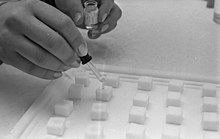
A potential, but rare, adverse effect of the oral polio vaccine (OPV) is its known ability to recombine to a form that may cause neurological infection and cause paralysis. Clinical disease, including paralysis, caused by vaccine-derived poliovirus (VDPV) is indistinguishable from that caused by wild polioviruses. This is believed to be a rare event, but outbreaks of vaccine-associated paralytic poliomyelitis (VAPP), caused by a circulating vaccine-derived poliovirus (cVDPV), have been reported, and tend to occur in areas of low coverage by OPV, presumably because the OPV is itself protective against the related outbreak strain.
Contamination concerns
In 1960, it was determined that the rhesus monkey kidney cells used to prepare the poliovirus vaccines were infected with the SV40 virus (Simian Virus-40). SV40 was also discovered in 1960 and is a naturally occurring virus that infects monkeys. In 1961, SV40 was found to cause tumors in rodents. More recently, the virus was found in certain forms of cancer in humans, for instance brain and bone tumors, pleural and peritoneal mesothelioma, and some types of non-Hodgkin's lymphoma. However, it has not been determined that SV40 causes these cancers.
SV40 was found to be present in stocks of the injected form of the polio vaccine (IPV) in use between 1955 to 1963. It is not found in the OPV form. Over 98 million Americans received one or more doses of polio vaccine between 1955 to 1963 when a proportion of vaccine was contaminated with SV40; it has been estimated that 10–30 million Americans may have received a dose of vaccine contaminated with SV40. Later analysis suggested that vaccines produced by the former Soviet bloc countries until 1980, and used in the USSR, China, Japan, and several African countries, may have been contaminated; meaning hundreds of millions more may have been exposed to SV40.
In 1998, the National Cancer Institute undertook a large study, using cancer case information from the Institute's SEER database. The published findings from the study revealed that there was no increased incidence of cancer in persons who may have received vaccine containing SV40. Another large study in Sweden examined cancer rates of 700,000 individuals who had received potentially contaminated polio vaccine as late as 1957; the study again revealed no increased cancer incidence between persons who received polio vaccines containing SV40 and those who did not. The question of whether SV40 causes cancer in humans remains controversial however, and the development of improved assays for detection of SV40 in human tissues will be needed to resolve the controversy.
During the race to develop an oral polio vaccine several large scale human trials were undertaken. By 1958, the National Institutes of Health had determined that OPV produced using the Sabin strains were the safest. Between 1957 and 1960, however, Hilary Koprowski continued to administer his vaccine around the world. In Africa, the vaccines were administered to roughly one million people in the Belgian territories, now the Democratic Republic of the Congo, Rwanda and Burundi. The results of these human trials have been controversial, and accusations in the 1990s arose that the vaccine had created the conditions necessary for transmission of SIV from chimpanzees to humans, causing HIV/AIDS. These hypotheses have, however, been refuted in some studies. By 2004, cases of poliomyelitis in Africa had been reduced to just a small number of isolated regions in the western portion of the continent, with sporadic cases elsewhere. However, recent opposition to vaccination campaigns has evolved, often relating to fears that the vaccine might induce sterility. The disease has since resurged in Nigeria and in several other African nations, which epidemiologists believe is due to refusals by certain local populations to allow their children to receive the polio vaccine.
ইতিহাস
সাধারণত, টীকা দেয়ার মাধ্যমে দেহের ইমিউন বা প্রতিরক্ষা ব্যবস্থায় 'ইমিউনোজেন' প্রবেশ করানো হয়। কোনো সংক্রামক প্রবেশ করানোর মধ্য দিয়ে দেহের প্রতিরক্ষা ব্যবস্থা কর্তৃক সাড়া পাবার প্রক্রিয়াকে বলা হয় 'ইমিউনিজেশন'। পোলিও টীকা গ্রহণের ফলে দেহে যে প্রতিরক্ষা ব্যবস্থা তৈরি হয় তা এক ব্যক্তি থেকে আরেক ব্যক্তিতে বন্য পোলিও ভাইরাস ছড়ানোর ক্ষেত্রে বাধার সৃষ্টি করে। ফলস্বরূপ, পোলিও টিকা গ্রহণকারী ব্যক্তি এবং বিপুলসংখ্যক জনগোষ্ঠী — উভয়ই রক্ষা পায়। উক্ত দু'প্রকার পোলিও টিকার উদ্ভাবন প্রথম আধুনিক সার্বজনীন টিকাপ্রদান কর্মসূচীর সূচনা করে। বন্য ভাইরাসের সংক্রমণের ফলে মার্কিন যুক্তরাষ্ট্রে সর্বশেষ paralytic poliomyelitis-এ আক্রান্ত হওয়ার ঘটনা ঘটে ১৯৭৯ সালে মধ্য-পশ্চিম রাজ্যগুলোতে।
১৯৩৬
১৯৩৬ সালে মরিস ব্রুডি, নিউ ইয়র্ক ইউনিভার্সিটির একজন গবেষণা সহকারী, একটি বানরের সুষুম্না স্নায়ু থেকে পোলিও টীকা তৈরির প্রচেষ্টা চালান যেখানে ফরমালডিহাইড (HCHO) পোলিও ভাইরাস মারার কাজে ব্যবহৃত হত। কিন্তু প্রয়োজনীয় ভাইরাস সংগ্রহ সংক্রান্ত জটিলতার দরুন তার প্রাথমিক প্রচেষ্টা ব্যর্থ হয়। ব্রুডি তার নিজের শরীরেই প্রথম পরীক্ষা চালান এবং পরে তার কয়েকজন সহযোগীর শরীরেও এই পরীক্ষা চালান। পরে তিনি তিন হাজার শিশুকে এই টীকা দেন। এই শিশুদের অনেকের মাঝে এলার্জিজনিত প্রতিক্রিয়া লক্ষ করা গেলেও কেউই পোলিও রোগ থেকে ইমিউনিটি পায় নি।ফিলাডেলফিয়ার প্যাথোলজিস্ট জন কোমারও একই সালে একটা টীকা তৈরির দাবী করেন, কিন্তু এটাও ইমিউনিটি তৈরিতে কোনো ভূমিকা রাখতে পারে নি এবং প্যারালাইটিক পোলিও (মস্তিষ্ক ও স্নায়ু ধ্বংসকারী) রোগগুলোর জন্য একে দায়ী করা হয় যাদের মধ্যে নয়টিই ছিল মারাত্মক।
১৯৪৮
A breakthrough came in 1948 when a research group headed by John Enders at the Children's Hospital Boston successfully cultivated the poliovirus in human tissue in the laboratory. This group had recently successfully grown mumps in cell culture. In March 1948 Thomas H. Weller was attempting to grow varicella virus in embryonic lung tissue. He had inoculated the planned number of tubes when he noticed that there were a few unused tubes. He retrieved a sample of mouse brain infected with polio virus and added it to the remaining test tubes, on the off chance that the virus might grow. The varicella cultures failed to grow but the polio cultures were successful. This development greatly facilitated vaccine research and ultimately allowed for the development of vaccines against polio. Enders and his colleagues, Thomas H. Weller and Frederick C. Robbins, were recognized in 1954 for their labors with a Nobel Prize in Physiology or Medicine. Other important advances that led to the development of polio vaccines were: the identification of three poliovirus serotypes (Poliovirus type 1 — PV1, or Mahoney; PV2, Lansing; and PV3, Leon); the finding that prior to paralysis, the virus must be present in the blood; and the demonstration that administration of antibodies in the form of gamma globulin protects against paralytic polio.
১৯৫২–১৯৫৩
যুক্তরাষ্ট্রে মহামারীতে একবার ৫৮,০০০ এবং আরেকবার ৩৫,০০০ মানুষ পোলিও রোগে আক্রান্ত হয়েছিল। এ সময় প্রতি বছরই গড়ে মোট ২০,০০০ জন পোলিও রোগে ভূগত। এই মহামারী ঠেকাতে যুক্তরাষ্ট্রে বাণিজ্যিকভাবে লক্ষ লক্ষ ডলার বিনিয়োগ করা হয়েছিল যার উদ্দেশ্য ছিল পোলিও টীকা তৈরি এবং বাজারজাতকরণ। নিউ ইয়র্কে এইচ. আর. কক্স এর নেতৃত্বাধীন লেডার্লি ল্যাবরেটরি ছিল এরকমই একটি বিনিয়োগ প্রতিষ্ঠান। এখানে কাজ করতেন পোল্যান্ডে জন্ম নেয়া ভাইরোলজিস্ট ও ইমিউনোলজিস্ট হিলারি কপ্রোভস্কি। ১৯৫০ সালে তিনিই সর্বপ্রথম সফলভাবে পোলিও টীকা তৈরির দাবি করেন। কিন্তু তার তৈরি টীকাতে জীবিত ভাইরাস ব্যবহার করা হয়েছিল (জীবিত পোলিও ভাইরাস প্রতিষেধক হিসেবে ব্যবহার করা যায় না, আর মুখ দিয়ে খাওয়া তো পরের কথা)। ফলে টীকাটি ব্যবহারের অনুপযুক্ত ছিল যতদিন পর্যন্ত না জোনাস সল্ক-এর (মৃত ভাইরাস থেকে বানানো) পোলিও টীকা বাজারে আসে।
কপ্রোভস্কির নিষ্ক্রিয় ভাইরাস থেকে তৈরি টিকাকে সুইস আলবিনো ইঁদুরদের মস্তিষ্কের মধ্য দিয়ে চালনা করা হয়। সপ্তম চালনা শেষে যে টিকা পাওয়া যায় তা আর স্নায়ু টিস্যুকে সংক্রমিত করে না কিংবা পক্ষাঘাত ঘটায় না। ইঁদুরের উপরে আরও এক থেকে তিনবার চালনা শেষে উক্ত টিকাকে মানুষের ব্যবহারের উপযুক্ত বলে বিবেচনা করা হয়। কপ্রোভস্কির জীবদ্দশাতেই, ১৯৫০ সালের ২৭ ফেব্রুয়ারিতে প্রথমবারের মতো দূর্বল ভাইরাস দ্বারা তৈরি টীকার পরীক্ষা চালানো হয় লেচওয়ার্থ ভিলেজের (নিউ ইয়র্কে অবস্থিত শারীরিক ও মানসিকভাবে বিকারগ্রস্তদের জন্য নিবেদিত একটি প্রতিষ্ঠান) এক আট বছর বয়সী শিশুর ওপর। শিশুটির মাঝে কোনো প্রকার পার্শ্বপ্রতিক্রিয়া না হওয়ায় কপ্রোভস্কি আরও ১৯ জনের উপর পরীক্ষা চালান।
জোনাস এডওয়ার্ড সল্ক
১৯৫২ সালে পিটসবার্গ বিশ্ববিদ্যালয়ে জোনাস সল্ক-ই সর্বপ্রথম কার্যোপযোগী পোলিও টিকার উদ্ভাবন করেন। তবে এর কার্যকারিতা পরীক্ষার জন্য প্রয়োজন ছিল কয়েক বছরের পরীক্ষা-নিরীক্ষা। তিনি ২৬ মার্চ, ১৯৫৩ সালে সিবিএস রেডিওতে একটা প্রতিবেদন প্রকাশ করেন, যেখানে শিশু এবং বয়ষ্কদের নিয়ে গঠিত একটি ছোট গোষ্ঠীর উপরে সফলভাবে এ টিকার পরীক্ষা চালানোর কথা বলা হয়। এর মাত্র দুই দিন পর JAMA-তে উক্ত পরীক্ষার ফলাফল প্রকাশ করা হয়। ১৯৫৪ সালের ২৩ ফেব্রুয়ারিতে আর্সেনাল ইলিমেন্টারি স্কুল এবং দ্য ওয়াটসন হোম ফর চিল্ড্রেন, পিটসবার্গ, পেন্সিল্ভেনিয়া-তে পরীক্ষামূলকভাবে এ টিকা দেয়া হয়। পরবর্তীতে সল্কের এ টিকা টমাস ফ্রান্সিস-এর নেতৃত্বে ফ্রান্সিস ফিল্ড ট্রায়াল নামক একটি পরীক্ষায় ব্যবহৃত হয়। এ পরীক্ষাটি ইতিহাসের অন্যতম বড় চিকিৎসা-সম্পর্কিত পরীক্ষা। এ পরীক্ষাটি শুরু হয়েছিল ফ্রাঙ্কলিন শেরম্যান ইলিমেন্টারি স্কুল, ম্যাকলিন, ভার্জিনিয়ার প্রায় ৪,০০০ শিশুদের নিয়ে এবং পরবর্তিতে মার্কিন যুক্তরাষ্ট্রের ৪৪টি রাজ্যের প্রায় ১৮ লাখ শিশুদেরকে এর আওতায় আনা হয় পরিসংখ্যান অনুসারে, প্রায় ৪.৪ লাখ শিশুদের এই টিকা ইঞ্জেকশনের মাধ্যমে এক বা একাধিকবার প্রদান করা হয়, আরো ২.১ লাখ শিশুকে দেয়া হয় অক্ষতিকর প্লাসিবো, এবং বাকী ১২ লাখ শিশুকে কোনো টিকা-ই দেয়া হয় না। এদেরকে শুধু মাত্র কন্ট্রোল গ্রুপ হিসেবে রাখা হয়। ১৯৫৫ সালের ১২ এপ্রিল (প্রেসিডেন্ট ফ্রাঙ্কলিন ডি. রুজভেল্ট-এর দশম মৃত্যুবার্ষিকীতে, ধারণা করা হয় যে তার প্যারালাইসিস-এর নেপথ্যে পোলিও দায়ী ছিল) এই পরীক্ষার ফলাফল ঘোষণা করা হয়। সল্কের টিকা PV1 (পোলিও ভাইরাস টাইপ ওয়ান)-এর ক্ষেত্রে ৬০-৭০%, PV2 এবং PV3-এর ক্ষেত্রে ৯০%-এরও বেশি এবং বাল্বার পোলিও দমনের ক্ষেত্রে ৯৪%-এরও বেশি ফলপ্রসূ ছিল। ১৯৫৫ সালে সল্কের টিকার লাইসেন্স নেয়া হয়, এবং শীঘ্রই শিশুদের মাঝে টিকাপ্রদান কর্মসূচী গৃহীত হয়। মার্কিন যুক্তরাষ্ট্রে মার্চ অব ডাইমস-এর নেতৃত্বে আয়োজিত সার্বজনীন টিকাদান কর্মসূচীর ফলে বার্ষিক পোলিও আক্রান্ত রোগীর সংখ্যা ১৯৫৩ সালে ৩৫,০০০ থেকে ১৯৫৭ সালে ৫,৬০০-এ নেমে আসে। ১৯৬১ সালে মার্কিন যুক্তরাষ্ট্রে মাত্র ১৬১ জন রোগী চিহ্নিত করা হয়।
১৯৮৭
১৯৮৭ সালের নভেম্বরে মার্কিন যুক্তরাষ্ট্রে একটি বর্ধিত কার্যক্ষম IPV-এর লাইসেন্স দেয়া হয়, এবং এটিই আজ অবধি মার্কিন যুক্তরাষ্ট্রে ব্যবহার হয়ে আসছে। শিশু জন্ম নেয়ার পরপরই (সাধারণতঃ এক থেকে দুই মাসের মধ্যে) পোলিও টিকার প্রথম ডোজটি দেয়া হয়, এবং পরের ডোজটি দেয়া হয় ৪ মাস বয়সে। তৃতীয় ডোজ দেয়ার দিন-তারিখ নির্ভর করে টিকার ধরনের উপর। তবে এ ডোজটি ৬ থেকে ১৮ মাসের মধ্যেই দেয়া উচিত। ৪ থেকে ৬ বছরের মাথায় একটি বুস্টার ডোজ দেয়া হয়ে থাকে। ফলে বিদ্যালয়ে ভর্তি হওয়ার সময়পর্যন্ত মোট চারটি ডোজ দেয়া হয়। কোনো কোনো দেশে কৈশোর কালে পঞ্চম আরেকটি ডোজ দেয়া হয়। উন্নত দেশগুলোতে প্রাপ্তবয়স্ক (১৮ বছর বা তার বেশি বয়সধারী)-দের মাঝে আর পোলিও টিকা দেয়া হয় না কিংবা দেয়ার প্রয়োজনীয়তাও নেই। কেননা তারা ইতোমধ্যেই পোলিও ভাইরাস থেকে ইমিউন, এবং তাদের বুনো পোলিও ভাইরাসের সংস্পর্শে আসার ঝুঁকি অত্যন্ত কম। ২০০২ সালে মার্কিন যুক্তরাষ্ট্রে একটি পেন্টাভ্যালেন্ট (পাঁচটি উপাদানযুক্ত) টিকার অনুমোদন দেয়া হয়। এ পাঁচটি উপাদানের মধ্যে IPV-ও রয়েছে।
১৯৮৮
আলবার্ট সাবিনের প্রস্তুতকৃত ওরাল পোলিও টীকার উপর ভর করে ১৯৮৮ সাল থেকে বিশ্ব স্বাস্থ্য সংস্থা, ইউনিসেফ এবং রোটারি ফাউন্ডেশনের নেতৃত্বে বৈশ্বিকভাবে পোলিও প্রতিরোধে প্রচেষ্টা চালানো শুরু হয়।
১৯৯০ পরবর্তী সময়
১৯৯৪ সালের মধ্যে পোলিও দুই আমেরিকা থেকে বিলুপ্ত হয়ে যায়। ২০০০ সালে এ রোগটিকে চীন, অস্ট্রেলিয়াসহ মোট ৩৬টি পশ্চিম-প্রশান্ত মহাসাগরীয় দেশ থেকে আনুষ্ঠানিকভাবে বিলুপ্ত ঘোষণা করা হয়। ২০০২ সালে ইউরোপকে পোলিও মুক্ত ঘোষণা করা হয়। জানুয়ারি ২০১১ থেকে ভারতে আর কোনো পোলিও রোগীর সন্ধান পাওয়া যায়নি; ফলশ্রুতিতে ফেব্রুয়ারি ২০১২ সালে ভারতকে WHO এর পোলিও আক্রান্ত দেশের তালিকা থেকে বাদ দেয়া হয়। ২০১৪ সালের মার্চে ভারতকে পোলিও মুক্ত দেশ হিসেবে ঘোষণা করা হয়।
২০০৮ সালের পর মাত্র তিনটি দেশে পোলিও মহামারী দেখা গেছে: নাইজেরিয়া, পাকিস্তান ও আফগানিস্তান। যদিও বিশ্বের অধিকাংশ স্থানে পোলিও ভাইরাস ছড়ানো প্রতিরোধ করা গেছে, বুনো পোলিও ভাইরাস এখনও ছড়াচ্ছে, এবং পূর্বের পোলিও-মুক্ত এলাকাগুলোতেও বুনো পোলিও ভাইরাস ছড়ানোর আশঙ্কা তৈরী হয়েছে। বিশেষতঃ যেসব এলাকায় টিকা কম দেয়া হয়েছিল বা যেসব এলাকার পয়ঃনিষ্কাশন ব্যবস্থা ভাল নয়, সেসব স্থানে পোলিও ভাইরাসের আক্রমণ ঘটলে তা মহামারী আকার ধারণ করতে পারে। ফলে সকলকে পোলিও টীকার আওতায় আনা একান্ত জরুরী।
সমাজ ও সংস্কৃতি
মূল্য
২০১৪ সাল অনুযায়ী, ওরাল (মুখ দিয়ে খাওয়ার উপযোগী) ভ্যাক্সিনের পাইকারি মূল্য প্রতি ডোজে প্রায় মার্কিন $০.২৫।গ্লোবাল অ্যালায়েন্স ফর ভ্যাক্সিন্স এন্ড ইমিউনাইজেইশন উন্নয়নশীল দেশগুলোতে প্রতি ১০-ডোজের অক্রিয় পোলিও টিকার বোতলে প্রতি ডোজে প্রায় €০.৭৫ মূল্য রাখে। মার্কিন যুক্তরাষ্ট্রে অক্রিয় পোলিও টিকার মূল্য $২৫ থেকে $৫০। বাংলাদেশে সরকারিভাবে বিনামূল্যে পোলিও টিকা খাওয়ানো হয়ে থাকে।
ভুলধারণা
পাকিস্তানে একটি প্রচলিত ভুলধারণা রয়েছে যে পোলিও টিকায় হারাম উপকরণ রয়েছে এবং এটি ছেলে সন্তানের মাঝে পুরুষত্বহীনতা এবং বন্ধাত্ব তৈরি করতে পারে। ফলে কোনো কোনো পিতা-মাতা তাদের সন্তানদের এ টিকা দেয়া থেকে বিরত রাখেন। এই অন্ধবিশ্বাস বিশেষতঃ খাইবার পাখতুনখোয়া রাজ্য এবং FATA এলাকায় ব্যাপকভাবে লক্ষ করা যায়। পোলিও টিকাদাতা গোষ্ঠীর উপর আক্রমণের ঘটনাও ঘটেছে। ফলে পাকিস্তান থেকে পোলিও নির্মূলের আন্তর্জাতিক প্রচেষ্টা ব্যহত হচ্ছে। এ কারণে গোটা বিশ্বের পোলিও নির্মূল কার্যক্রমও ব্যহত হচ্ছে যেহেতু পোলিও ভাইরাস যে কেউ এক জায়গা থেকে অন্য জায়গায় বহন করতে পারে।
বিস্তারিত পড়তে
- Global Poilio Eradication Initiative ২০১৮ সালের মধ্যে পোলিও বিলুপ্তির লক্ষ্য বাস্তবায়নে চূড়ান্ত প্রজেক্ট
- History of Vaccines Website – History of Polio পর্তুগীজ ওয়েব আর্কাইভে আর্কাইভকৃত ১৫ মে ২০১৬ তারিখে History of Vaccines, ফিলাডেলফিয়ার ফিজিশিয়ান কলেজের একটি প্রজেক্ট
- PBS.org — 'People and Discoveries: Salk Produces Polio Vaccine 1952', PBS
- Conquering Polio, স্মিথসনিয়ান ম্যাগাজিন, এপ্রিল ২০০৫ সংখ্যা
- The Global Effort To Eradicate Polio ওয়েব্যাক মেশিনে আর্কাইভকৃত ১০ এপ্রিল ২০১৫ তারিখে, ড্রিম ২০৪৭ ম্যাগাজিন, এপ্রিল ২০০৪ সংখ্যা
